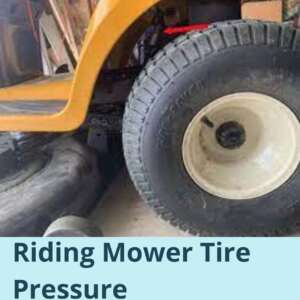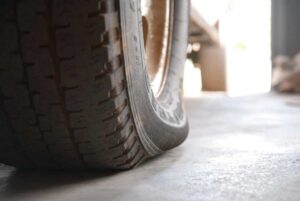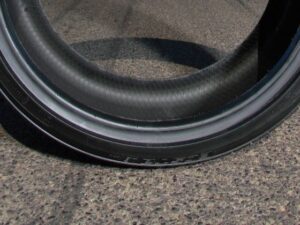Table of Contents
 Do you ever check your riding mower tire pressure? If you don’t, you’re likely not doing it enough. Checking your tire pressure is one of the simplest things you can do to protect your lawn and ensure that your riding mower is performing at its best.
Do you ever check your riding mower tire pressure? If you don’t, you’re likely not doing it enough. Checking your tire pressure is one of the simplest things you can do to protect your lawn and ensure that your riding mower is performing at its best.
Not only will checking your tire pressure help ensure that your lawn gets cut properly, but it can help prevent damage to your riding mower’s machine and deck.
In this article, we’ll cover all sizes, brands, and models of riding mowers to help you figure out what size tire pressure is right for you .
Riding Mower Tire Pressure – Things You Need To Know
Tires are important for your riding lawn mower. When they’re not inflated properly, you can run into all sorts of problems. Your machine will be less efficient, and you’ll be running the risk of damaging your engine. But there are so many different tires on the market that it can be difficult to find the right one for your machine. To make things simpler, we’ve compiled a list of what’s available and what each one is best suited for the mower.
Dangers of Low Tire Pressure

Tire pressure is important because it affects the performance of your vehicle, as well as its safety. If you have under-inflated tires, you might notice:
- Poor handling and traction in wet condition
- Poor braking performance
- A decrease in gas mileage
- Tire failure (which can lead to accidents)
- Increased wear on the tires and drivetrain components
Check Air Pressure in Your Mower’s Tires
-
- Park your tractor on level ground and engage the parking brake as securely as possible.
- Remove both front wheels from their axle shafts using an Allen wrench or socket wrench (this may require removing one or more nuts).
- Place a tire gauge in each tire’s valve stem hole and push it down until it touches the inner surface of the rim. It should register anywhere between 30-psi (pounds per square inch) and 60-psi depending upon what type of mower you have.
- Insert the gauge into the hole on top of the tire stem until it clicks shut. Push down on the gauge until it fills with air, then release it to stop inflating automatically (see illustration). Read off the PSI reading on the gauge face and compare it to what is stamped on each tire sidewall (see illustration).
Check Tire Pressure Using a Tire Gauge:
- Turn off the mower and wait five minutes so that it cools down sufficiently to allow safe handling without burning yourself with hot oil or gasoline.
- Check that all four tires have equal tread depth (about 2/32 inch). If one wheel has worn out more than another, replace it before proceeding with the next steps below because it will give inaccurate readings for other tires’ pressures
Types of Tires under their Brands and Models
According to the brand and models, there are many different mower tires and their air pressure types.
Some of the common types of mower tires used in riding mowers include:
Solid Tire
These are used on lawn tractors, zero-turn riding mowers, and other utility vehicles with a single rear wheel. They are made of solid rubber, which makes them very durable, but they can be heavy and can’t handle bumps well.
Radial Tire
These are used on lawn tractors with two rear wheels and offer better traction on rough terrain than solid tires. They also provide more stability at higher speeds than solid tires, but they are also heavier than other types of tires.
Tube-Type Tire

These are used on lawn tractors with two rear wheels with tubes inside them or on zero-turn riding mowers with four rear wheels without tubes inside them (therefore no inner tube).
They offer good traction in all conditions but don’t last as long as radial or solid tires because the tube can become damaged by hitting rocks or other objects while driving around your yard or farmland
Airless vs. Pneumatic Tires
Most riding mowers use pneumatic tires, with inner tubes filled with pressurized air.
These tires are typically more durable than airless alternatives and offer better traction in poor weather conditions like rain or snow. Some models also feature treads designed for added traction on slippery surfaces like grass or sand.
What PSI Stands for in Pressure
PSI stands for pounds per square inch. This is the unit of measurement used to determine how much air pressure is in your tire. The higher the PSI, the more air is in your tire. The lower the PSI, the less air is in your tire.
The best way to determine what PSI is right for you is by reading your owner’s manual or asking a professional at an auto parts store or dealership.
What PSI should Lawn Mower Tires be
Tire pressure will vary depending on what type of equipment you have, which may be riding mowers, garden tractors, zero-turn mowers, and more. The air pressure for all these types of equipment is usually expressed in pounds per square inch (PSI).
If you’re unsure what PSI your tires should be, check the owner’s manual for guidance. In general terms, the proper PSI depends on the manufacturer’s recommendations for that particular product.
The PSI (pounds per square inch) recommended for lawn mower tires is:
- 8- to 10-inch diameter tires: 35 to 40 PSI
- 11-inch to 13-inch diameter tires: 40 to 45 PSI
Check Lawn Tractor Tire Pressure and Why It is Important
A tire’s air pressure can vary by as much as 10 pounds per square inch (psi) depending on the temperature of the air and the type of tire. A tire under-inflated by just 2 psi can waste up to 7% of fuel, while over-inflated tires are less responsive and have higher rolling resistance, which wastes energy.
How do you know if your tires are under or over-inflated?
The easiest way is to look for the recommended inflation pressure on the sidewall of each tire. If it’s not there, use a tire gauge to measure the pressure at least once a month when the tires are cold — before driving on them after sitting overnight or longer in an unheated garage or shed.
If you don’t have a gauge or are unsure how to use one correctly, call your local fire department and ask them to send someone out with one. You can also buy one at any auto parts store for less than $10.
Final words
It is a pain if you have to go through the hassle of getting the riding mower tire pressure just right. This article covers everything you need to know about lawn mower tire pressure, from why it’s important to what PSI you should be using. It also covers the different types of tires available and how to check the air pressure.
